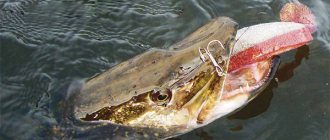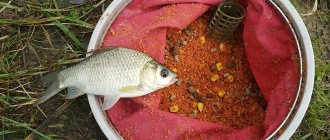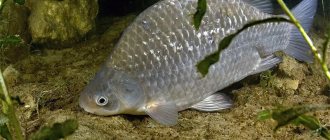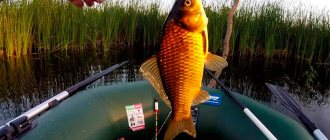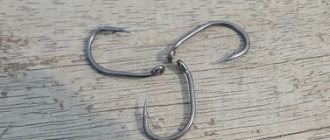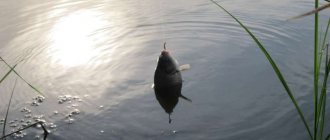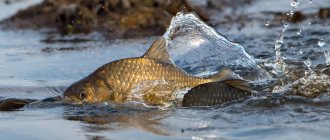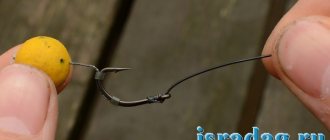Hooks for catching crucian carp are presented in a wide range on the modern market. However, in order to return with a catch, you need to choose this element correctly and store it correctly.
Hooks are purchased based on fishing conditions:
- Reservoir.
- Weather conditions.
- Season.
- Time of day.
- Tackle.
- Complementary foods and baits.
The body of water plays the most important role, so that’s where you need to start.
Weather conditions and season
It is best to go fishing for crucian carp in warm, windless and calm weather.
An excellent bite is observed a couple of weeks after the ice melts, when the fish begins to actively prepare for spawning. Things are somewhat more complicated in the hot season, no matter what hooks the fisherman has stocked up on for crucian carp. The situation is better with the arrival of August, when the fish begins to slowly but surely prepare for winter, so it tries to eat well and not disdain almost anything. At this moment, it is possible to catch crucian carp that is located not far from the pits or in the pits themselves. In winter, the bites are best on large rivers, where there is not and has not been the slightest hint of thickets. Although many fishermen in the wilderness sit at home, believing that regardless of the bait, as well as hooks, it will be difficult to catch fish.
Factors influencing choice
Some people believe that a fishhook can be anything, but this is not true. If you pick up a product that is not suitable at all, then you can wait forever for bites. If you want to catch crucian carp, you need to purchase a small element, because the fish has a small mouth.
Hooks are selected based on:
- Size.
- Material.
- Forms.
- Thickness.
- One-liners.
Size
If we talk about the numbering that exists in our country, it differs from the international one, which all modern manufacturers rely on. In Russian numbering, the numbers go from larger to smaller - from 2.5 to 20. At the same time, the number is the distance between the tip and the fore-end, indicated in millimeters. Crucian carp is caught using product No. 6.
This is not the case with foreign numbering. There, small sizes are indicated by large numbers and vice versa. The number is directly between the width of the hook and the length of the shank.
Many anglers are looking for the best hooks for crucian carp, which have names. If you look at the packaging, you can see there the product number, purpose (for which fish it should be used and for what bait). For a small fish, you can safely take hooks, based on the international classification, with number 17. If a fisherman goes to fish for a large fish, then you should give preference to number 14.
Important! Crucian carp rarely swallows bait; it often clings to the hook on the edge of its lip, so you need to buy a small element.
Material
Steel spring thread is the material from which almost all hooks are made. However, at the same time, the hook for crucian carp is made from high-carbon steel, which is then further processed. All products are plated with NB-black nickel. Experts say that if rust is noticed on an element, it can be moistened with automobile oil or stuck into a piece of soap.
It is worth saying that when thinking about which hook to choose for crucian carp, you need to pay attention to color. Considering that fish bite best on blue and black, you should purchase elements of this shade.
If during the fishing process it was noticed that the hook began to deform, it can be thrown away, because the part must be strong and durable.
Form
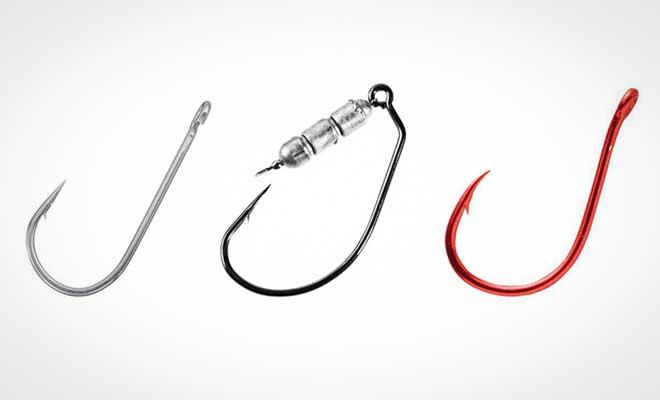
The shape depends on the type of fishing. Although the majority of fishermen prefer round hooks, they are standard single hooks, which show excellent results. At the same time, you need to understand that if fishing is done with float gear, then the tip should be thin and straight. If fishing is done near the bottom, the tip, on the contrary, should bend inward so that the fish does not escape. As for the forend, it should be a couple of times longer than the bend.
Thickness
When fishing with a worm or bloodworm, the thickness should be such that after attaching to the hook, the bait remains mobile. In the case when the role of the nozzle is played by dough, corn or porridge, then the hook size can be larger.
Acuity
You need to catch crucian carp with sharp hooks, the axis of which is slightly shifted. The sharpening must be good. It’s very easy to check: if you run the sting over the pad of your finger, you’ll see that it kind of sticks. If the product is a little dull, it can be sharpened by rubbing it on the side of matches - where these same matches are struck. You need to tie the hook on a ring or on a shoulder blade. Some fishermen say there is no difference. However, the fishing line rubs against the blade faster, which leads to rupture of the knot. Therefore, it is better to still pay attention to the ring.
Criterias of choice
There are no universal hooks for catching crucian carp. The habits of this fish, its size, lifestyle, and diet may differ even in neighboring reservoirs, so you will still have to pick it up in a “crucian” reservoir directly during fishing. Therefore, it is better for any angler to always have with him several species with different properties.
The standard hook for catching crucian carp is considered to be an element of equipment that has the following properties:
- Straight ring eye. Crucian carp is a strong fish, so the critical point in choosing gear is knots. Therefore, in crucian carp tackle it is customary to use hooks with a ring-shaped head. This element of the equipment, tied to the leash using a clinch-type knot, can guarantee the reliability of the connection. In float rigs designed for crucian carp fishing, a hook with a ring-shaped head is a well-established tradition. However, in crucian bottom tackle, fishermen still use hooks with a “spade” type head. Especially if the leashes in this gear are short, and instead of monofilament fishing line, nylon thread is used. In equipment such as “nipple”, “plug” and “spring”, hooks with a “spade” type head are quite successfully used.
- Standard handguard. It is difficult to give advice on choosing the length and shape of the forend. In any case, the fisherman has to select a hook for the bait, adapting to the tastes of the fish in a particular body of water. For example, to catch a large worm, you need to use a hook with a long shank (preferably with serrations on the shank). For catching pearl barley, bloodworms or maggots, a model with a short straight shank is suitable. In the classic float rig, hooks with a straight, standard shank are used, the length of which depends solely on the chosen bait.
- The tip should be bent inward. The question of the shape of the sting is the subject of much debate among anglers. There is a common belief that the sting should be curved inward (“claw”). But people have been catching crucian carp for several hundred years. And the sting of this form appeared only in the twentieth century.
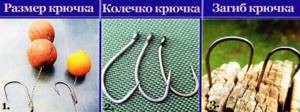
In carp fishing, it is actively promoted by well-known manufacturers of expensive products. For catching small and medium-sized fish, a hook with a standard straight tip, which is familiar to most anglers, is quite sufficient. For catching large crucian carp, a hook with a curved sting is quite applicable and quite effective. That is, it can be used in equipment for catching crucian carp, but the “claw” is not a mandatory element of crucian carp equipment.
How to choose based on bait
Experienced people sort hooks not only by numbers, but also by bait. In order for fishing to go well, it is advisable to select the same size bait and hook. It is worth saying that the sting may peek out a little from the reverse side. When using worms, you should take species with long shanks. As for putting on the nozzle, it is carried out according to the “stocking” principle. You can also take a thin one with beards on the fore-end, which are turned in the other direction. This is very convenient, since you can be sure that the bait will not jump off or fly away during casting. If we talk about sizes, then it can be size 10, as well as 12.
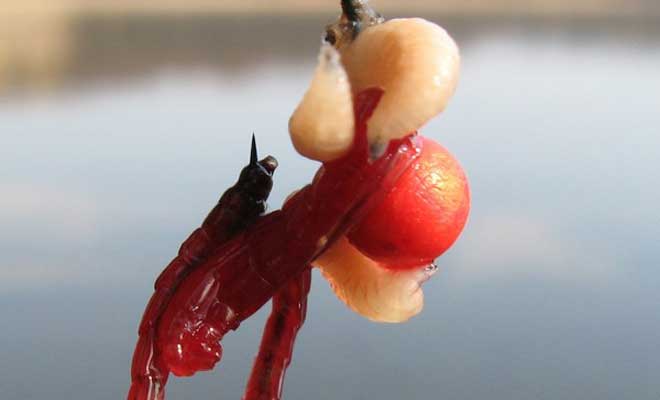
A completely different matter is a bloodworm hook, which should be small, thin, but extremely sharp. Planting must be done carefully so that the delicacy does not lose its “presentation”. Having decided to use bloodworms together with maggots, which will increase the chances of a bite, choose a larger hook. The ideal option would be number 18 or 20. If you use only maggots, then it is better to take products number 16.
Particular attention is paid to plant bait and hook. So, if you decide to use dough, then it is better to buy a special element with a spring on the fore-end, which will allow you to better insert the delicacy. You can use a size 18 hook with this bait.
Hooks with a spring for catching crucian carp
Wary fish must be lured just as carefully, if possible without using large baits, so as not to scare away the prey. In this case, use a hook with a spring on the fore-end. The cavity of the spring is filled with soft bait, such as mash, bread, porridge, or batter. Bait is placed on the sting. In this form the bait is thrown to the fish. The spring prevents the dough or mash from jumping off when casting and serves as a feeder.
Video: how to make a hook with a spring with your own hands
Most popular hooks
Despite the fact that there are a great variety of different hooks on sale, there are some that are more popular.
These should include:
- Keiryu. These are blue hooks that are usually used for bottom fishing. Given the dark color and depth, you can achieve almost complete invisibility so as not to scare the fish.
- Maruseigo-bh. The product is made in black color to allow fishing closer to the bottom. The hooks are made of high strength wire. Thanks to the serrations on the fore-end, the bait holds better.
- Chinu With Eye. These are elements with a forged subdivision. The part has a beard that is bent slightly to the side. These hooks are used for float and bottom fishing.
- Iseama With Eye. These hooks are universal. They can be used to catch not only crucian carp, but also all other fish.
- Pin hook. Domestic fishermen are looking at this product with special care, because the choice of hook sizes is incredibly rich.
- Worm SP-BH. This is a bright red hook that can be seen from afar. Due to the long fore-end, the bait will not curl up. The product is used if the angler is going to engage in bottom fishing.
- Kappastyle 2. The presented hooks are purchased by people who fish with a float. A small beard prevents the fish that has bitten from jumping off the hook.
Choosing a hook depending on the gear
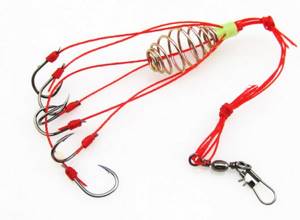
When fishing at short distances, the bait flies with weak acceleration, so the bait almost never flies off the hook. When fishing at short distances, you can use any type of hook. The above is true in relation to the elements of equipment when using feeders such as “spring”, “plug”, “nipple” in bottom fishing - gear where the bait is immersed in the bait when casting.
In this case, both the bait and the bait form a single mass at the time of casting. There is practically no risk of losing the bait when casting.
Another thing is float tackle for long casting, regardless of the type of tackle. It is worth using hooks made of thin wire to cast baits such as steamed or boiled grain, corn (boiled or canned), and bloodworms. For a worm in case of long casting, it is better to use a hook made of thick wire, but always with notches on the fore-end.
